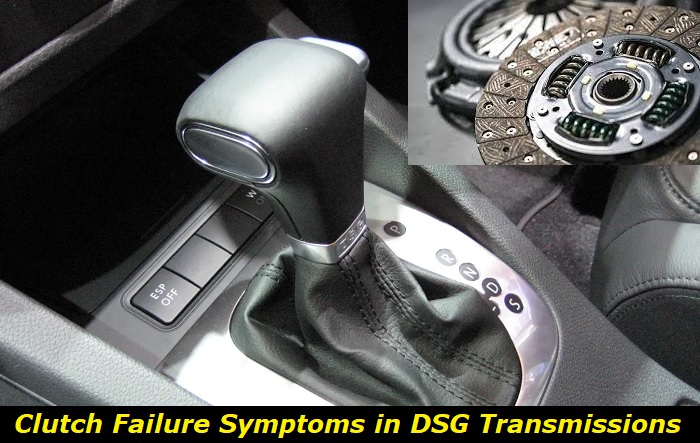The most common symptoms of DSG clutch wear include slipping in-between gears, shuddering and juddering, and the generation of a fault code. You'll see the best repairs for DSG clutch wear as well as ways to avoid it in later subheadings.
7-speed DSG transmissions highlights
- Average lifespan:110,000-130,000 miles
- Reliability Score:Low
- Prone to minor issues:Yes
- Price for repair after failure:$1,500-$3,000
- Price for replacement:$5,000-$6,000
- Availability of parts:Good
- Common problems:clutch kit failure, control module problems, mechatronic issues.

How Does a Direct-Shift Gearbox Work?
A Direct-shift gearbox is engineered by Volkswagen to operate as two separate gearboxes. These gearboxes are linked to the engine via two driveshafts. The double gearboxes and double clutches are controlled by a mechatronics system with the aid of hydraulic power.
Engine power is transmitted to the gearbox by the clutches, unlike that of the conventional automatic transmission which uses the torque converter instead. The former is more efficient than the latter in this aspect.
An advantage of using a car that features a DSG is the automatic shifting. The system can predict the next gear you're likely to change to and prepare for it in advance. It's a fast and seamless process that's better than that of the traditional automatic transmission.
The DSG system is always ready to switch to the next gear before withdrawing from the present gear position. For example; the fourth gear will already be waiting in position even if the car is still in the third gear. This shift happens in 10 milliseconds, while traction is constant. It's always nearly unnoticeable.
Another advantage is that there's no loss of power during the optimal gear shifting. Fuel efficiency is ensured this way. Vehicle owners get more comfort and make fewer visits to the gas station. But one of the certain flaws is the durability. DSG transmissions are thought to be the least durable VW transmissions.
DSGs require frequent maintenance which not many vehicle owners like to keep up with. And problems like clutch wear are likely to manifest if you don't maintain it well.
Signs of DSG Clutch Wear
There are so many things that could go wrong with the DSG, especially if the maintenance guidelines aren't followed properly. I've presented many of the symptoms below:
1) Shuddering and Juddering
Your car's DSG transmission should be totally smooth. You shouldn't feel any shakes or vibrations, or see them as normal. Shuddering and juddering happen when the vehicle is accelerating and shifting from the first gear to a higher one. This symptom is most common on seven-speed DSG transmissions.
2) Slipping
Slipping happens during acceleration when the engine builds up RPMs (revolutions per minute), but the clutch doesn't engage on time. There are many other reasons why this may come up while driving as listed below.
- Gearbox electronics fault
- Wrong data from the mechatronic unit
- Malfunctioning TCU (transmission control unit)
However, the most common source is worn clutch packs. It occurs in regular manual transmissions as well (although featuring a single clutch). You can't be too sure that the clutches are at fault without scanning your car for error codes.
3) Abnormal Increase in Engine Speed
A worn clutch can raise the engine's speed without a gear shift occurring. This will lead to confusion in vehicle handling while driving.
4) Abnormal Shifts To Neutral
Your car may be going into neutral instead when you want to shift to the third gear. An error code usually creates awareness of this fault when a scanner is hooked up to the vehicle.
It may be described as an "implausible mechanical gear disengagement fault", especially for some vehicle models that have done over 20,000 miles. This may just mean that you need to reset the clutches.
5) Delayed Engagement
This is not a common symptom of clutch wear, but it can be problematic to diagnose. Your direct-shift gearbox may experience a second delay at the moment between when you shift into gear and when driving starts. The delay will be easy to notice and should feel abnormal.
6) Heavy Banging
This can negatively affect the dual mass flywheels of your car if you take it for granted. It will cause the vehicle to stop abruptly.
Best Repairs for DSG Clutch Wear Issues
I've described all the best repairs I can in this section. They've been presented based on some of the symptoms mentioned in the previous subheading.
1) Solution To Shuddering and Juddering
You may have to replace the transmission's clutch packs here. This is because worn clutches begin to shake or vibrate when they're under much pressure. Check for error codes related to worn clutch packs to confirm that it's the source of the problem. The culprit may just be a failed solenoid instead.
Changing or checking your DSG clutches isn't a DIY task or a job for a novice mechanic. It's a complex procedure that involves taking apart a system of many components. My candid advice is to hire a mechanic for everything from a physical examination to the swapping out of the clutch packs.
The replacement job usually takes hours and it's labor-intensive. You'll be spending $1,000-$1,500 for labor only. And the cost of the parts isn't cheap either. Expect to pay maybe $1,500 or more to purchase replacement parts, depending on your car model. That sets the total cost at a considerable minimum of $2,500!
The above cost is in line with recent quotes for a 7-speed DSG clutch change. You now know why you have to be absolutely sure that it's necessary to change the clutch packs.
Procrastinating the swap can lead to adverse ripple effects for other parts of the transmission, especially the flywheels. A DSG clutch should be routinely changed after a minimum of 100,000 miles. You can wait for 120,000 miles or delay till as far as 150,000 miles. But 100,000 miles is the safest.
2) Solution To Slipping
It's advisable not to go the DIY way with this issue due to the many possibilities involved. Get it checked by an expert and repair/replace the affected parts. Vehicle diagnostics will show you if it's a worn clutch or an electrical fault.
You can try to swap out the DSG fluid, particularly if it hasn't been replaced in a long time. This is a common fix for slipping, apart from changing the clutches. It may be a necessity if you experience grinding, friction, or resistance during shifts. DSG fluid should be replaced at least every 40,000 miles.
3) Solution To Delayed Engagement
This may be pointing to other issues apart from the clutches; so note the potential need to replace the transmission, brake light sensor, or valve bodies.
Precautions That Will Help Your DSG Clutch Last Longer
It's possible to avoid clutch wear or at least prolong its lifespan. Take note of the following dos and don'ts:
1) Routine maintenance
Regular checks and servicing of the gearbox cannot be overemphasized. For example, fluid and filter changes. Vehicle manufacturers warn against using transmission fluid additives, so it's advisable to avoid them.
2) Don't Utilize the Accelerator on a Slope
This is a common mistake that puts great pressure on the gearbox. The clutch will be engaged and start slipping, thereby generating too much heat. Clutches wear faster than normal because of this. You should rather stop the vehicle from moving backward by depressing the brake pedal.
3) Always Launch the Vehicle Properly
Keep in mind that DSG clutches wear faster than those of regular automatic transmissions. This is because of the smooth and quick shifts. So a rough launch will definitely put more pressure on the clutches.
Launch correctly by following the car manufacturer's guidelines. Don't rev the motor while the brakes are engaged, or else both the clutches and brake components will suffer forced wear.
4) Avoid Upshifting While Braking
Upshifting while braking will transmit confusing commands to the ECU and it might hinder the circuits. You'll get similar results from downshifting when accelerating.
The transmission and engine will run at incompatible speeds, causing a slight slip between the flywheel and the clutch. The clutch will wear faster from such slips.
5) Don't Switch To Neutral Wrongly
Avoid shifting to neutral at a red light so that the transmission won't get confusing commands. You should rather depress the brake pedal and use "(D)rive" in such a situation. It will release both clutches safely till you depress the pedal again.
Conclusion
In addition to the above, downshift with one gear at a time and don't overload the DSG. Endeavor to follow the manufacturer's gearbox maintenance guidelines as well.
Hopefully, the issue with your transmission won't require a full gearbox swap. It's $1,000-$2,500 for labor alone. Be sure that changing the entire unit is needed and not a few cheaper components. Lastly, a diagnostic test & report for transmission-related issues can cost any amount from $100.
About the authors
The CarAraC research team is composed of seasoned auto mechanics and automotive industry professionals, including individuals with advanced degrees and certifications in their field. Our team members boast prestigious credentials, reflecting their extensive knowledge and skills. These qualifications include: IMI: Institute of the Motor Industry, ASE-Certified Master Automobile Technicians; Coventry University, Graduate of MA in Automotive Journalism; Politecnico di Torino, Italy, MS Automotive Engineering; Ss. Cyril and Methodius University in Skopje, Mechanical University in Skopje; TOC Automotive College; DHA Suffa University, Department of Mechanical Engineering






Add comment